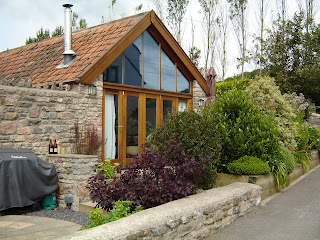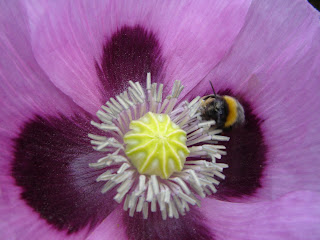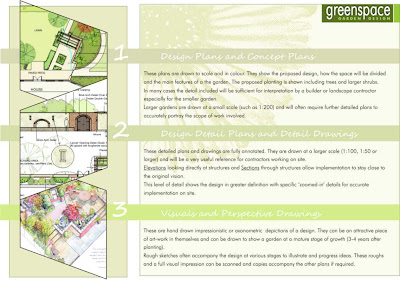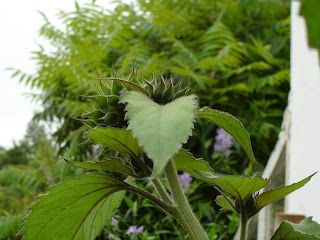I was really excited to take on this commission towards the end of last year. Already having designed the space for my client, comprising a sunken courtyard garden area with a fireplace and hot-tub, I produced a couple of rough ideas and my client chose one of them. This large painting was a challenge at 3.5m wide on a very textured wall surface, applied to the wall in stages over about 4 days.
Having headed out into the world of design many years ago as a student with a BA in Fine Art this has been an interesting and inspiring return to my roots!
Greenspace Garden Design
Welcome to our 2018 garden design and gardening blog. Find some great ideas here for your own garden...
Monday, 12 January 2015
Thursday, 18 April 2013
Plants for Bees...
With every new garden planting plan we can help our local bee population to survive. Bees as you know are vital for pollination of food crops and with some species of bee - honey is an added bonus. Next time you're looking for something new in your beds and borders think of bees! Plants such as Sedum spectabile, Lavender, Verbena and Globe Thistle (Below) are just a few good sources of nectar.
Also Poppies - shown below is Papaver somniferum which opens beautiful crumpled petals to reveal a bee restaurant inside.
Also Poppies - shown below is Papaver somniferum which opens beautiful crumpled petals to reveal a bee restaurant inside.
Wednesday, 11 July 2012
Hard and Soft Landscaping ... getting the balance right
Now of course you know the difference, hard = constructed surfaces, walls, paving etc and soft = natural, plants, lawn, trees etc. Creating balance between the built and manmade areas of a garden and the natural elements is key to any successful design.
When choosing items for a garden it's interesting that less is more. The best way of focusing attention on any one item is to place it within its opposite. For example a courtyard space with man-built surfaces will focus attention and amplify the nature of a single tree within that space. Similarly a stone or ceramic item placed within and amongst plants will be the focal point within the scheme, though small relatively speaking. Its position and presence can be a constant source of pleasure when it appears in view around a corner or through a gateway.
When choosing items for a garden it's interesting that less is more. The best way of focusing attention on any one item is to place it within its opposite. For example a courtyard space with man-built surfaces will focus attention and amplify the nature of a single tree within that space. Similarly a stone or ceramic item placed within and amongst plants will be the focal point within the scheme, though small relatively speaking. Its position and presence can be a constant source of pleasure when it appears in view around a corner or through a gateway.
Tuesday, 31 January 2012
" A thing of beauty is a joy forever..." ~ John Keats
" But if the thing of beauty is a garden, then only if it gets...
... weeded, pruned, tidied, and mown"
(Kathryn Gilmour)
Even better, why not put a garden designer's know-how to use to get a garden layout right, right from the start.
The benefits are simple...
... weeded, pruned, tidied, and mown"
(Kathryn Gilmour)
Even better, why not put a garden designer's know-how to use to get a garden layout right, right from the start.
The benefits are simple...
- A clear design will ensure that time and money aren't wasted.
- What's more a good looking garden can add value even to the smallest plot.
- A garden designer can help you sift through all those dream garden books to highlight your needs and preferences and to select the right plants for you.
- A good range of plants will add year-round interest and enjoyment.
- The garden can be easily managed.
- You'll feel like spending much more time outdoors for leisure and pleasure.
 |
| Before |
 | |
| After |
Tuesday, 7 June 2011
Design Plans and Drawings Explained...
I am writing a series of information 1/3rd A4 leaflets that will be available soon to download. Here is the first one.
This first one is to help people choose the right kind of plans and drawings for their project. Let me know what you think.
This first one is to help people choose the right kind of plans and drawings for their project. Let me know what you think.
Wednesday, 30 March 2011
£6.8 Billion spent on gardens
The Budget has been uppermost on everyone's mind. Last year it was estimated that Brits would spend about £6.8 Billion on their gardens and that's about £420 for every garden owning household in UK during 2010. What I wonder is how much of that money was wasted? Two projects last year are shown below, when Greenspace was called in to help put right two different situations. And the amount the owners could have saved if they'd got good advice and had recommendation for a reliable contractor right from the start.
Think what you might save on your project this summer with some good advice right from the start!
As a designer part of my job is to get maximum effect in your garden within what you can afford. Balancing beauty and cost is what I aim to do for all my clients and what I could do for you too. Great gardens that won't need a rethink later on. Yes they'll need care and attention and yes there may be a few losses from extreme weather, but a good garden design ensures your garden will look good at completion and will mature beautifully. Don't leave it to chance - get some good advice right from the start.
Think what you might save on your project this summer with some good advice right from the start!
As a designer part of my job is to get maximum effect in your garden within what you can afford. Balancing beauty and cost is what I aim to do for all my clients and what I could do for you too. Great gardens that won't need a rethink later on. Yes they'll need care and attention and yes there may be a few losses from extreme weather, but a good garden design ensures your garden will look good at completion and will mature beautifully. Don't leave it to chance - get some good advice right from the start.
Monday, 7 March 2011
Bricks, Mortar and Boundaries
A Planning Application has flown through first time for this major garden wall design, which is great news for all involved at Greenspace Garden Design and also for our client too!
If you are thinking of a major change to a boundary in your garden then STOP just for a minute and run a finger down this simple checklist of questions and ask yourself....
- Are there any planning restrictions on the site? If not sure check your deeds or enquire with your local Planning Dept.
- Are there any other structures, buildings or trees close by? Think about how a new structure will affect these and vice versa.
- Is the boundary shared with a neighbour? If so talk to them first.
- How will the new boundary look in relation to the whole garden? If you are not sure about this point ask a garden designer to help.
To save time and save money - it pays to get it right first time.
Tuesday, 22 February 2011
Beauty & the Beast
Beauty has to fall in love with the Beast just the way he is before he can be transformed into the highly desirable guy of her dreams. Um now, you may be wondering how this relates to gardens and you may be even more surprised when I tell you that this fairy tale is happening right outside your back door.
I am talking about clay soil - the Beast. If you've tried digging deep you'll know what I mean and you'll probably know that large swathes of South West England are covered in clay soil. Difficult to work, heavy, slow to warm up and if left unimproved will spell certain death for many relationships with plants.
Okay, so the key is to love the soil just the way it is, and this means...
Rule 1 - Doing some research - Don't try to grow plants that need well drained soil.
Rule 2 - Developing True Grit - Get plenty of sand and/or grit dug into it over a year or so, or certainly when adding new planting.
Rule 3 - Learning Patience - It's going to take time for your garden to grow beautifully because it takes time to love the beast just the way it is.
But when you do, something wonderful happens, because of all the soil-types clay is potentially the most fertile and some of the most beautiful and productive gardens have been crafted on clay.
If you have a garden problem or garden design question, why not POST it here in comments and I will get back to you.
I am talking about clay soil - the Beast. If you've tried digging deep you'll know what I mean and you'll probably know that large swathes of South West England are covered in clay soil. Difficult to work, heavy, slow to warm up and if left unimproved will spell certain death for many relationships with plants.
Okay, so the key is to love the soil just the way it is, and this means...
Rule 1 - Doing some research - Don't try to grow plants that need well drained soil.
Rule 2 - Developing True Grit - Get plenty of sand and/or grit dug into it over a year or so, or certainly when adding new planting.
Rule 3 - Learning Patience - It's going to take time for your garden to grow beautifully because it takes time to love the beast just the way it is.
But when you do, something wonderful happens, because of all the soil-types clay is potentially the most fertile and some of the most beautiful and productive gardens have been crafted on clay.
If you have a garden problem or garden design question, why not POST it here in comments and I will get back to you.
Friday, 4 February 2011
Take one garden and just add sunlight!
Ever planted something in the wrong place? A position that later turns out to be too shady, or even too sunny for a particular plant that you fell in love with at a local Garden Centre. Making the most of your growing potential involves closely observing that wonderful thing called the Sun. At this time of year we see little glimpses of it here and there, just hinting that Spring truly is just around the corner.
If you take a look at the diagram I have drawn here, it is amazing to see just how low in the sky the Winter Sun really is - and how a garden with high fences or a northerly aspect will be affected. Changes in growing conditions are all part of the garden design process. An excellent way of making sure your space is fully utilised is to check levels of sunlight and how they will change throughout the year. If you want great results with plants and veggies, sunlight is of paramount importance, when laying out your beds.
But it's not just about getting the best growing conditions for plants alone. How about you?
When I set foot in a garden, I look for something that I like to call 'Sun-trap potential'. I am looking for even just a small area, that is out of the cold wind. So a sheltered little nook can suffice, if it's in the right position to catch available sunlight, just for an hour or two in the depths of December. If I can find a sun-trap, then I know that a small seat placed there will be appreciated all year round. So if you are planning out your garden always see if you can make space for a seat or two in a little sunny nook. I am not saying that you won't need your overcoat, but you can soak up those precious rays during short days, and so can any plants nearby.
If you have a garden problem or question why not POST it here in comments and I will get back to you. Also I would love to know how you get on this year with any of the ideas or inspiration you find on this blog. Let me know.
If you take a look at the diagram I have drawn here, it is amazing to see just how low in the sky the Winter Sun really is - and how a garden with high fences or a northerly aspect will be affected. Changes in growing conditions are all part of the garden design process. An excellent way of making sure your space is fully utilised is to check levels of sunlight and how they will change throughout the year. If you want great results with plants and veggies, sunlight is of paramount importance, when laying out your beds.
But it's not just about getting the best growing conditions for plants alone. How about you?
When I set foot in a garden, I look for something that I like to call 'Sun-trap potential'. I am looking for even just a small area, that is out of the cold wind. So a sheltered little nook can suffice, if it's in the right position to catch available sunlight, just for an hour or two in the depths of December. If I can find a sun-trap, then I know that a small seat placed there will be appreciated all year round. So if you are planning out your garden always see if you can make space for a seat or two in a little sunny nook. I am not saying that you won't need your overcoat, but you can soak up those precious rays during short days, and so can any plants nearby.
If you have a garden problem or question why not POST it here in comments and I will get back to you. Also I would love to know how you get on this year with any of the ideas or inspiration you find on this blog. Let me know.
Saturday, 6 March 2010
Spring-clean your garden with care...
Kathryn Gilmour at Greenspace Garden Design says, "garden spring-clean is good thing to do... BUT ladybirds are still hibernating. Removing too much dead garden bits and old dropped leaves even in March can leave them with no cover. There is such a thing called 'garden hygiene' and yes it sounds a bit clinical, and yet in a small space, by keeping it orderly and clean you'll help to cut down on pests and diseases. A balance has to be struck between order and providing cover for beneficial hibernating bees and ladybirds".
This is THE deluxe accommodation for ladybirds and bumble bees. There are several different designs available and the time to install them isn't actually now it is late summer or early autumn ideally.
But if you are doing an early spring clean and you happen to disturb ladybirds, as I did during February, then there are several make shift solutions that will protect them through the remaining cold weather and this is what I did:
Des-res #1 - The upturned flowerpot with dried leaf and grass interior. This is anchored with a stick so it can't blow away.
Des-res #2 - Old perennial growth secured with twine. Ladybirds venture out of the middle when warm enough.
Des -res #3 - Plastic container (courtesy of Riverside Tandoori) with exit hole cut, dried leaf interior and covered for shade (bark in this instance).
This is THE deluxe accommodation for ladybirds and bumble bees. There are several different designs available and the time to install them isn't actually now it is late summer or early autumn ideally.
But if you are doing an early spring clean and you happen to disturb ladybirds, as I did during February, then there are several make shift solutions that will protect them through the remaining cold weather and this is what I did:
Des-res #1 - The upturned flowerpot with dried leaf and grass interior. This is anchored with a stick so it can't blow away.
Des-res #2 - Old perennial growth secured with twine. Ladybirds venture out of the middle when warm enough.
Des -res #3 - Plastic container (courtesy of Riverside Tandoori) with exit hole cut, dried leaf interior and covered for shade (bark in this instance).
Ladybirds feed on aphids and are an asset in your garden - take care of them and enjoy their presence. They are supposed to be lucky too apparently and I reckon that I re-homed about 20, so it looks like I could be in for a luck filled year :)
Subscribe to:
Comments (Atom)
















